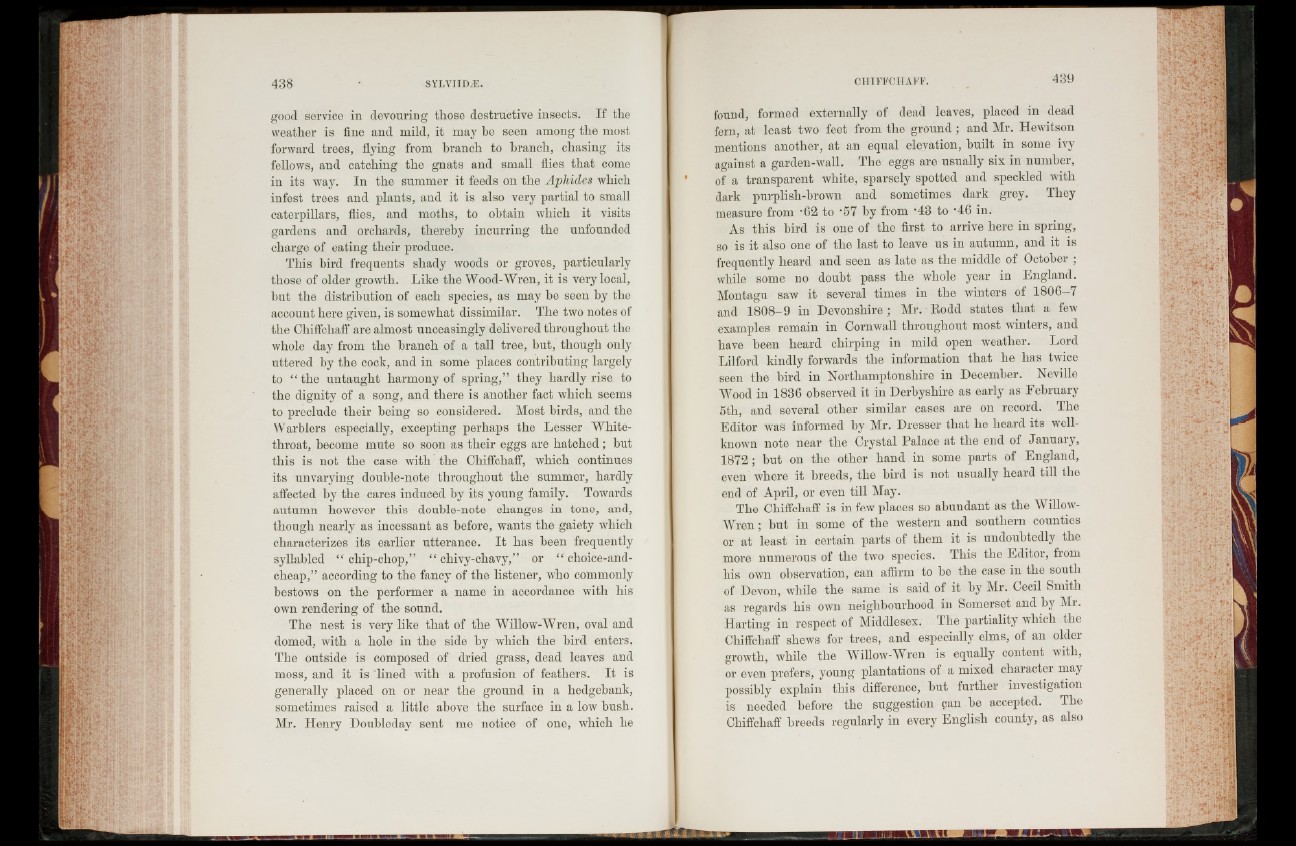
good service in devouring those destructive insects. If the
weather is fine and mild, it may be seen among the most
forward trees, flying from branch to branch, chasing its
fellows, and catching the gnats and small flies that come
in its way. In the summer it feeds on the Aphides which
infest trees and plants, and it is also very partial to small
caterpillars, flies, and moths, to obtain which it visits
gardens and orchards, thereby incurring the unfounded
charge of eating their produce.
This bird frequents shady woods or groves, particularly
those of older growth. Like the Wood-Wren, it is very local,
hut the distribution of each species, as may he seen by the
account here given, is somewhat dissimilar. The two notes of
the Chiffcliaff are almost unceasingly delivered throughout the
whole day from the branch of a tall tree, but, though only
uttered by the cock, and in some places contributing largely
to “ the untaught harmony of spring,” they hardly rise to
the dignity of a song, and there is another fact which seems
to preclude their being so considered. Most birds, and the
Warblers especially, excepting perhaps the Lesser White-
throat, become mute so soon as their eggs are hatched; hut
this is not the case with the Cliiffchaff, which continues
its unvarying double-note throughout the summer, hardly
affected by the cares induced by its young family. Towards
autumn however this double-note changes in tone, and,
though nearly as incessant as before, wants the gaiety which
characterizes its earlier utterance. I t has been frequently
syllabled “ chip-chop,” “ chivy-cliavy,” or “ choice-and-
cheap,” according to the fancy of the listener, who commonly
bestows on the performer a name in accordance with his
own rendering of the sound.
The nest is very like that of the Willow-Wren, oval and
domed, with a hole in the side by which the bird enters.
The outside is composed of dried grass, dead leaves and
moss, and it is lined with a profusion of feathers. I t is
generally placed on or near the ground in a hedgebank,
sometimes raised a little above the surface in a low hush.
Mr. Henry Doubleday sent me notice of one, which he
found, formed externally of dead leaves, placed in dead
fern, at least two feet from the ground; and Mr. Hewitson
mentions another, at an equal elevation, built in some ivy
against a garden-wall. The eggs are usually six in number,
of a transparent white, sparsely spotted and speckled with
dark purplish-brown and sometimes dark grey. They
measure from -62 to ’57 by from -43 to ‘46 in.
As this bird is one of the first to arrive here in spring,
so is it also one of the last to leave us in autumn, and it is
frequently heard and seen as late as the middle of October ;
while some no doubt pass the whole year in England.
Montagu saw it several times in the winters of 1806-7
and 1808-9 in Devonshire ; Mr. Rodd states that a few
examples remain in Cornwall throughout most winters, and
have been heard chirping in mild open weather. Lord
Lilford kindly forwards the information that he has twice
seen the bird in Northamptonshire in December. Neville
Wood in 1836 observed it in Derbyshire as early as February
5tli, and several other similar cases are on record. The
Editor was informed by Mr. Dresser that he heard its well-
known note near the Crystal Palace at the end of January,
1872 ; hut on the other hand in some parts of England,
even where it breeds, the bird is not usually heard till the
end of April, or even till May.
The Chiffcliaff is in few places so abundant as the Willow-
Wren ; but in some of the western and southern counties
or at least in certain parts of them it is undoubtedly the
more numerous of the twro species. This the Editor, fiom
his own observation, can affirm to he the case in the south
of Devon, while the same is said of it by Mr. Cecil Smith
as regards his own neighbourhood in Somerset and by Mi.
Harting in respect of Middlesex. The partiality which the
Chiffcliaff shews for trees, and especially elms, of an older
growth, while the Willow-Wren is equally content with,
or even prefers, young plantations of a mixed charactei may
possibly explain this difference, hut further investigation
is needed before the suggestion can he accepted. The
Chiffcliaff breeds regularly in every English county, as also